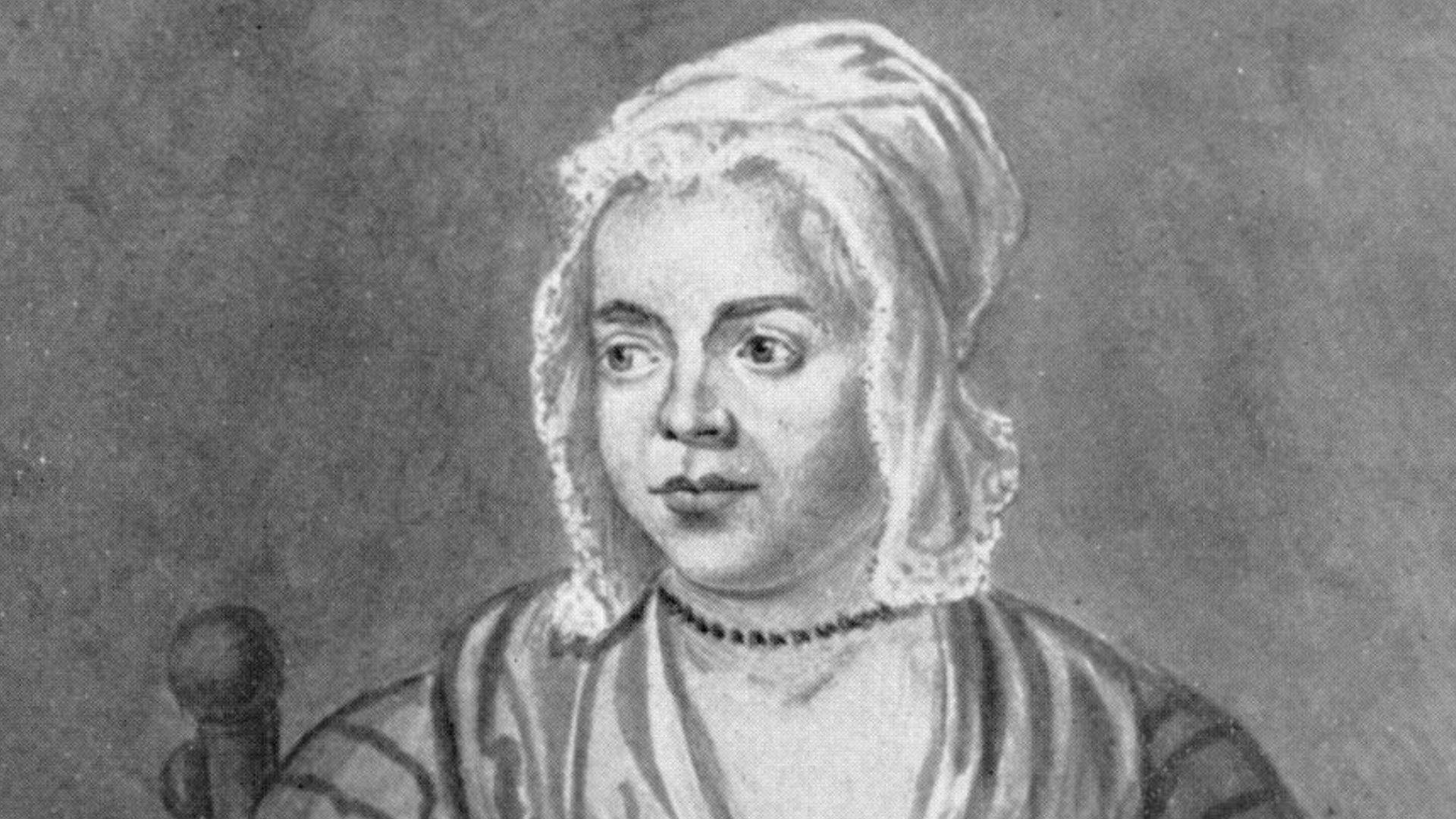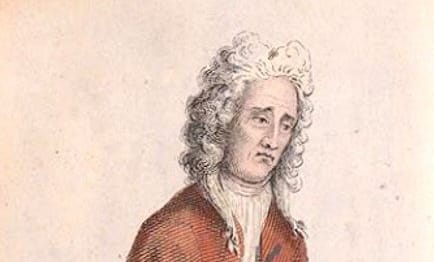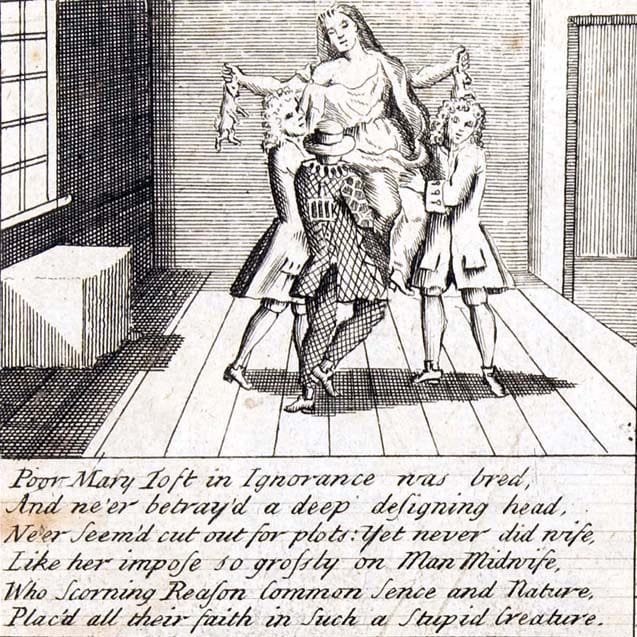How Mary Toft Gave Birth to Rabbits—and an Elaborate Hoax
There is an infamous 18th-century medical phenomenon that is heavily documented through several pamphlets, letters, and books held in the Hunterian Museum collection in Scotland. The news of a woman giving birth to rabbits reached the court of King George I and eventually made a fool of the medical community in London.
Mary Toft, who became known as the woman who gave birth to rabbits, was a peasant English woman from Godalming, Surrey. Toft became the subject of controversy when she tricked doctors into believing that she had given birth to rabbits.
The Birth of Mary Toft and Her Infamous Rabbits
On September 27, 1726, Mary Toft went into labor. The 24-year-old peasant’s neighbor, Mary Gill, came to aid Toft as she went through an agonizing labor. Gill reported that Toft hovered over a bucket, and something unrecognizable happened.

Source: John Laguerre/Wikimedia Commons
According to Mental Floss, Gill fetched Toft’s sister-in-law, who was a midwife by trade, to tell her the baffling news. Mary Toft’s “baby” didn’t look like a human child at all, but a rotten ball of animal parts.
The Medical Community Doubts Mary Toft’s Ability
Local surgeon, John Howard, examined the baby, writing that they resembled “three legs of a cat of tabby color and one leg of a rabbit … in them were three pieces of backbone of an eel.”

Source: Cleveland Museum of Art
Howard was skeptical that the thing that came out of Mary Toft was human, to begin with. Begrudgingly, she visited Toft, in which she complained that she was difficult to work with, writing “[Mary is] of a very stupid and sullen temper” (via Mental Floss). Then, Howard changed his mind after Toft gave birth to something shocking.
A Surgeon Witness Mary Toft’s Rabbit Birth
Howard gave witness to Mary Toft giving birth to rabbits. The news of Toft’s extraordinary births spread like wildfire, and made her a local celebrity. Over the next month, the Mother of Rabbits would give birth to eight more baby rabbits. Howard preserved the bodies of the rabbits in alcohol and sent letters to prominent physicians across England, hoping to find a solution to the mystery.

Source: Drew de F Fawkes/Flickr
“Imagining Monsters: Miscreations of the Self in Eighteenth-Century England” author Dennis Todd found a note in which Howard wrote on Nov. 9: “I have taken or deliver’d the poor Woman of three more Rabbets, all three half grown, one of them a dunn Rabbet; the last leap’d twenty three Hours in the Uterus before it dy’d. As soon as the eleventh Rabbet was taken away, up leap’d the twelfth Rabbet, which is now leaping. If you have any curious Person that is pleased to come Post, may see another leap in her Uterus, and shall take it from her if he pleases .. I do not know how many Rabbets may be behind.”
The King Gets Involved
Nathaniel St. André, the surgeon to King George I, received Howard’s letter. King George I became curious about the case and sent St. André to investigate. Unfortunately, St. André was not known for his medical prowess but was given the job as a surgeon because he spoke German, the king’s native language.

Source:National Portrait Gallery London/Public Domain/Picryl
St. André visited Mary Toft, feeling her belly and stating that her right Fallopian tube was creating the baby rabbits and that pressure crushed the rabbit into pieces. St. André later believed that his diagnosis was correct when he helped Toft deliver a rabbit’s head with some body parts of a cat, her 15th non-human baby.
The Story Mary Toft Told About the Phenomenon
Over the next few weeks, the entire country learned about Mary Toft and her strange ability to birth rabbits. In November, “Mist’s Weekly Journal” reported on the phenomenon, which helped spread Mary’s story.

Source: Internet Archive Book Images/Flickr
According to the report, Toft had miscarried her first child. During that time, she could only think about rabbits, somehow manifesting and giving birth to them. While some believed that Toft and her rabbits were an abomination, many looked at the issue with curiosity.
The Public Became Fascinated with the Story
While skeptics like Richard Manningham attempted to disprove Mary Toft’s strange ability, the stories that traveled through many of the English papers in circulation at the time would only boast the story as truth.

Source: Rijksmuseum/Public Domain/Flickr
The story piqued people’s interest, but it also turned the public against eating any rabbit, negatively affecting rabbit-peddling merchants. “The public horror was so great that the rent of rabbit-warrens sank to nothing; and nobody, till the delusion was over, presumed to eat a rabbit,” wrote James Caulfield.
Doubts about Authenticity of Mary Toft's Rabbits Start
Fascinated by the pickled rabbits brought back to London, the king sent Cyriacus Ahlers to Mary Toft in November. Ahlers found Toft was not exhibiting any signs of pregnancy. He assumed the entire thing was a hoax after observing Toft pressing her knees and thighs together as if she was keeping something from “dropping down” (via “Mary Toft—The Rabbit Breeder”).

Source: Public Domain/Atlas Obscura
Despite this, Ahlers believed that what Toft felt was very real pain. Ahlers returned to London with several of Toft’s rabbits. Upon closer study, Ahlers reportedly found evidence that they had been cut with a man-made tool. However, the king wanted to see Toft give birth in front of him, and arranged for Mary to be transported to London.
The Hoax is Revealed
Promised a royal pension for her journey, Mary Toft agreed to travel to perform her shocking ability for the king. Locked away in a bathhouse, with King George’s court watching her at any given moment, Toft suddenly stopped birthing rabbits.

Source: University of Glasgow Library/Atlas Obscura
In early December, a porter reported that Toft had attempted to bribe him into smuggling pieces of rabbit into her quarters. A colleague of St. André, Richard Manningham, confronted Toft, who rejected the accusation until she was threatened with exploratory surgery. Fearful for her life, Toft broke down, confessing that the whole thing had been a hoax.
Why Did Mary Toft Give Birth to Rabbits?
What likely caused Mary Toft to create this hoax is uncertain. The Paris Review believes that Toft likely caught a glimpse of the stagecoach life of exotic and wealthy people who lived eventful lives.

Source: Public Domain/Atlas Obscura
In Toft’s own stories, she had developed an agonizing craving for rabbit meat, obsessing over it as the Tofts’ income was spread thin over the family of five. She possibly thought that she could showcase herself and her “human monstrosities” as many parents did to their conjoined twins of stillborn children, so she could make a little extra money.
The Public Has a Field Day with the News
Journalists and satirists in London enjoyed making fun of the entire event, taking special digs at St. André, after discovering that Mary Toft had been lying. London’s medical community was ridiculed for their gullibility and ineptitude, all while benign accused of being “dirty old men whose peccadilloes they cloaked behind erudite mumbo jumbo” (The Paris Review).

Source: William Hogarth/The Met Museum
William Hogarth helped popularize the 18th-century London slang word coney, which became a double pun on the Latin word for rabbit (cuniculus) and female genitalia (cunnus) with his illustration “Cunicularii.”
What Happened to Mary Toft?
Mary Toft apologized, blaming her husband, mother-in-law, and the wife of a local organ grinder for pushing her into performing the hoax, in which she inserted the body of a cat and the head of a rabbit into her cervix while it was still open after her miscarriage. The lady who gave birth to rabbits ended up serving several weeks in Bridewell prison where the public could come in and humiliate her for a small fee.

Source: William Hogarth/Public Domain
After her release, Toft gave birth to a little girl and attempted to avoid the unfortunate title she had earned for the rest of her life. While Toft seemingly disappeared from records, a newspaper reported that she was convicted of a petty theft. Toft died in 1763, with her epitaph reading: Mary Toft, Widow, the Impostress Rabbitt.
